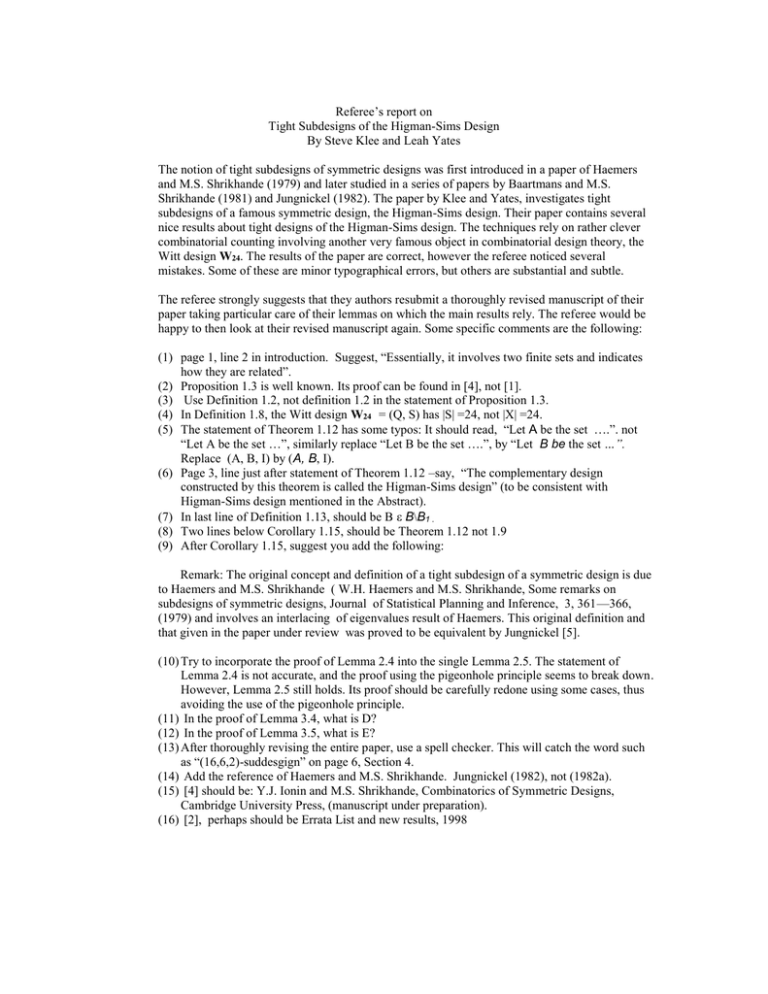Referee’s report on Tight Subdesigns of the Higman-Sims Design
advertisement

Referee’s report on Tight Subdesigns of the Higman-Sims Design By Steve Klee and Leah Yates The notion of tight subdesigns of symmetric designs was first introduced in a paper of Haemers and M.S. Shrikhande (1979) and later studied in a series of papers by Baartmans and M.S. Shrikhande (1981) and Jungnickel (1982). The paper by Klee and Yates, investigates tight subdesigns of a famous symmetric design, the Higman-Sims design. Their paper contains several nice results about tight designs of the Higman-Sims design. The techniques rely on rather clever combinatorial counting involving another very famous object in combinatorial design theory, the Witt design W24. The results of the paper are correct, however the referee noticed several mistakes. Some of these are minor typographical errors, but others are substantial and subtle. The referee strongly suggests that they authors resubmit a thoroughly revised manuscript of their paper taking particular care of their lemmas on which the main results rely. The referee would be happy to then look at their revised manuscript again. Some specific comments are the following: (1) page 1, line 2 in introduction. Suggest, “Essentially, it involves two finite sets and indicates how they are related”. (2) Proposition 1.3 is well known. Its proof can be found in [4], not [1]. (3) Use Definition 1.2, not definition 1.2 in the statement of Proposition 1.3. (4) In Definition 1.8, the Witt design W24 = (Q, S) has |S| =24, not |X| =24. (5) The statement of Theorem 1.12 has some typos: It should read, “Let A be the set ….”. not “Let A be the set …”, similarly replace “Let B be the set ….”, by “Let B be the set …”. Replace (A, B, I) by (A, B, I). (6) Page 3, line just after statement of Theorem 1.12 –say, “The complementary design constructed by this theorem is called the Higman-Sims design” (to be consistent with Higman-Sims design mentioned in the Abstract). (7) In last line of Definition 1.13, should be B B\B1 . (8) Two lines below Corollary 1.15, should be Theorem 1.12 not 1.9 (9) After Corollary 1.15, suggest you add the following: Remark: The original concept and definition of a tight subdesign of a symmetric design is due to Haemers and M.S. Shrikhande ( W.H. Haemers and M.S. Shrikhande, Some remarks on subdesigns of symmetric designs, Journal of Statistical Planning and Inference, 3, 361—366, (1979) and involves an interlacing of eigenvalues result of Haemers. This original definition and that given in the paper under review was proved to be equivalent by Jungnickel [5]. (10) Try to incorporate the proof of Lemma 2.4 into the single Lemma 2.5. The statement of Lemma 2.4 is not accurate, and the proof using the pigeonhole principle seems to break down. However, Lemma 2.5 still holds. Its proof should be carefully redone using some cases, thus avoiding the use of the pigeonhole principle. (11) In the proof of Lemma 3.4, what is D? (12) In the proof of Lemma 3.5, what is E? (13) After thoroughly revising the entire paper, use a spell checker. This will catch the word such as “(16,6,2)-suddesgign” on page 6, Section 4. (14) Add the reference of Haemers and M.S. Shrikhande. Jungnickel (1982), not (1982a). (15) [4] should be: Y.J. Ionin and M.S. Shrikhande, Combinatorics of Symmetric Designs, Cambridge University Press, (manuscript under preparation). (16) [2], perhaps should be Errata List and new results, 1998







